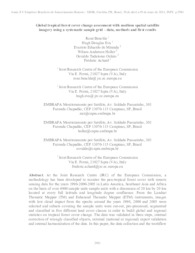Global tropical forest cover change assessment with medium spatial stellite imagery using a systematic sample grid - data, methods and first results.
Global tropical forest cover change assessment with medium spatial stellite imagery using a systematic sample grid - data, methods and first results.
Autoria: BEUCHLE, R.; EVA, H. D.; MIRANDA, E. E. de; HOLLER, W. A.; OSHIRO, O. T.; ACHARD, F.
Resumo: At the Joint Research Centre (JRC) of the European Commission, a methodology has been developed to monitor the pan-tropical forest cover with remote sensing data for the years 1990-2000-2005 in Latin America, Southeast Asia and Africa on the basis of over 4000 sample units sample units with a dimension of 20 km by 20 km located at every full latitude and longitude degree confluence. From the Landsat Thematic Mapper (TM) and Enhanced Thematic Mapper (ETM) instruments, images with low cloud impact from the epochs around the years 1990, 2000 and 2005 were selected and subsets covering the sample units were cut-out, pre-processed, segmented and classified in five different land cover classes in order to build global and regional statistics on tropical forest cover change. The data was validated in three steps, internal correction of wrongly classified objects, external (national or regional) expert validation and internal harmonization of the data. In this paper, the data collection and the workflow of the forest cover change assessment for the epochs 1990 and 2000 is presented. Parts of the results for the Brazilian Amazon have been validated by comparing with interpretations of corresponding samples carried out by the Instituto Nacional de Pesquisas Espaciais (INPE), showing a very high correlation. Further, the figure produced by INPE through the PRODES program on gross deforestation for the years 1990-2000 was compared to the figure calculated on basis of the JRC results for the respective area, where the JRC estimate that was ca. 10% higher than the INPE estimate.
Ano de publicação: 2011
Tipo de publicação: Artigo em anais e proceedings
Unidade: Embrapa Territorial
Palavras-chave: Landsat, Object-based classification, Tropical forest cover, monitoring
Observações
1 - Por padrão são exibidas publicações dos últimos 20 anos. Para encontrar publicações mais antigas, configure o filtro ano de publicação, colocando o ano a partir do qual você deseja encontrar publicações. O filtro está na coluna da esquerda na busca acima.
2 - Para ler algumas publicações da Embrapa (apenas as que estão em formato ePub), é necessário ter, no celular ou computador, um desses softwares gratuitos. Sistemas Android: Google Play Livros; IOS: iBooks; Windows e Linux: software Calibre.
Acesse outras publicações
Acesse a Base de Dados da Pesquisa Agropecuária (BDPA) para consultar o acervo completo das bibliotecas da Embrapa.

